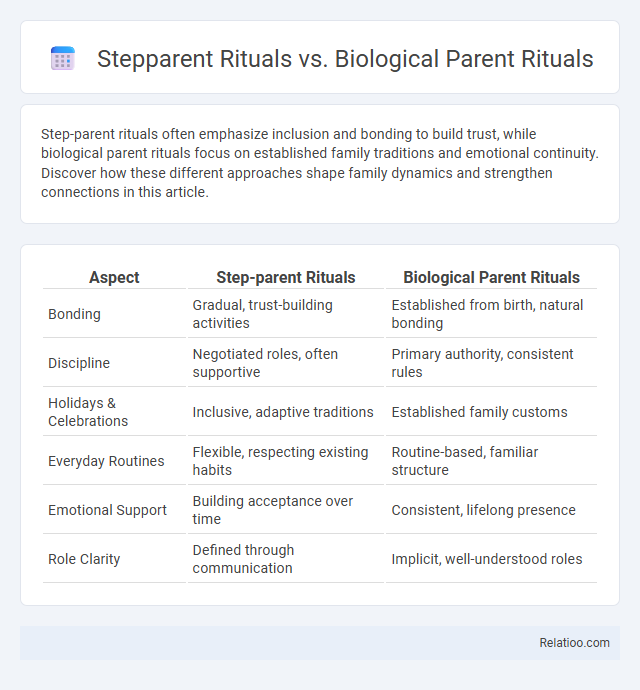Step-parent rituals often emphasize inclusion and bonding to build trust, while biological parent rituals focus on established family traditions and emotional continuity. Discover how these different approaches shape family dynamics and strengthen connections in this article.
Table of Comparison
| Aspect | Step-parent Rituals | Biological Parent Rituals |
|---|---|---|
| Bonding | Gradual, trust-building activities | Established from birth, natural bonding |
| Discipline | Negotiated roles, often supportive | Primary authority, consistent rules |
| Holidays & Celebrations | Inclusive, adaptive traditions | Established family customs |
| Everyday Routines | Flexible, respecting existing habits | Routine-based, familiar structure |
| Emotional Support | Building acceptance over time | Consistent, lifelong presence |
| Role Clarity | Defined through communication | Implicit, well-understood roles |
Defining Step-Parent and Biological Parent Rituals
Step-parent rituals involve unique traditions and practices that help integrate a new parental figure into the family dynamic, fostering trust and emotional bonds between step-parents and stepchildren. Biological parent rituals typically center on established behaviors and ceremonies that reinforce the natural parental role through shared history, genetic connection, and long-standing family customs. Your understanding of these rituals highlights the distinct emotional and cultural functions they serve within the broader family ritual framework, promoting cohesion and identity.
The Role of Rituals in Family Bonding
Rituals in family bonding serve distinct roles for step-parents and biological parents, shaping emotional connections and family identity through shared traditions and consistent practices. Biological parent rituals often reinforce genetic ties and early attachment, while step-parent rituals emphasize trust-building and inclusion, fostering a sense of belonging and unity within blended families. Overall, family rituals, regardless of parentage, create stability and collective memory, strengthening relational bonds and supporting the family's emotional resilience.
Common Biological Parent Rituals
Common biological parent rituals often include bedtime routines, family meals, and holiday traditions that foster bonding and stability among children. These rituals reinforce a sense of belonging and provide consistent structure, essential for child development and emotional security. Unlike step-parent rituals, biological parent rituals typically have deeper historical and emotional roots, reflecting shared heritage and ongoing family dynamics.
Unique Step-Parent Rituals
Step-parent rituals often emphasize creating new traditions that honor blended family dynamics, fostering inclusion and bonding through shared activities like storytelling or joint celebrations. Unlike biological parent rituals rooted in long-established family histories, unique step-parent rituals focus on building trust and affirming your role within the family unit. These rituals serve as intentional moments that strengthen connections and help navigate the complexities of blended family relationships.
Establishing New Traditions in Blended Families
Step-parent rituals often emphasize inclusion and bonding to create a sense of belonging, contrasting with biological parent rituals that tend to reinforce established family identities and heritage. Family rituals in blended families integrate elements from both biological and step-parent practices to forge unique traditions that honor all members' backgrounds. Establishing new traditions in blended families fosters cohesion, respect, and shared meaning, essential for navigating the complexities of redefined family roles.
Overcoming Challenges in Step-Parent Rituals
Overcoming challenges in step-parent rituals involves creating consistent and meaningful traditions that foster trust and connection with stepchildren, differentiating these from biological parent rituals which often have established patterns rooted in long-term family history. Your efforts to introduce inclusive family rituals can bridge gaps, easing tensions and building a shared sense of belonging among all family members. Emphasizing open communication and patience during these rituals strengthens bonds and helps integrate diverse family dynamics successfully.
Cultural Influences on Parental Rituals
Cultural influences shape step-parent rituals, biological parent rituals, and family rituals by dictating the roles, expectations, and practices associated with parenting in different societies. Biological parent rituals often emphasize biological bonds and heritage celebrations, while step-parent rituals may incorporate negotiated roles and blended family traditions to foster inclusion. Family rituals, influenced by cultural norms, reinforce identity and cohesion through shared customs that adapt to diverse family structures and intergenerational continuity.
Impact of Rituals on Child Well-Being
Step-parent rituals, biological parent rituals, and family rituals collectively contribute to a child's emotional security and identity formation by establishing consistent routines and reinforcing belonging. Your child's well-being benefits when these rituals promote a sense of stability, emotional bonding, and positive communication across diverse family structures. Research shows that inclusive and meaningful rituals enhance children's resilience, self-esteem, and overall mental health regardless of family composition.
Navigating Conflicts Between Rituals
Navigating conflicts between step-parent rituals, biological parent rituals, and family rituals requires sensitivity to the unique emotional bonds and traditions each role holds. Your ability to facilitate open communication and mutual respect ensures these diverse rituals coexist harmoniously, honoring both blended and biological family dynamics. Prioritizing shared values over competing customs strengthens family unity and creates meaningful, inclusive rituals for all members.
Tips for Harmonizing Step-Parent and Biological Parent Rituals
Harmonizing step-parent and biological parent rituals requires clear communication and mutual respect to create inclusive family traditions that honor both relationships. Establishing shared rituals like joint holiday celebrations, combined birthday parties, or collaborative weekend activities fosters unity while respecting individual family histories. Consistency and flexibility in scheduling rituals, along with involving children in planning, help bridge differences and strengthen emotional bonds across the blended family.

Infographic: Step-parent Rituals vs Biological Parent Rituals
 relatioo.com
relatioo.com